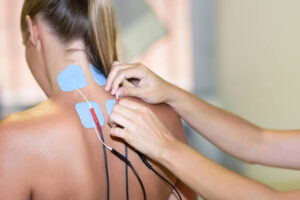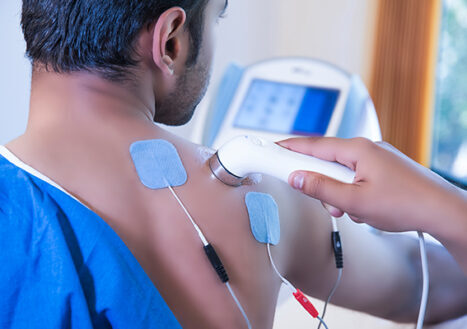If you’re wondering; what is electrotherapy treatment? then you’re certainly in the right place.
Perhaps you’re looking into electrotherapy treatment in Abbotsford for yourself, or you’d like to learn how and when to recommend it to your clients?
Whatever your reason for seeking treatment, we have everything you need to know about it, including what it is, how it works, and everything in between!
At Medela Rehabilitation, we offer a REPs-accredited electrotherapy course that can help anyone interested in the field gain a better understanding of the practice and, of course, apply what they’ve learned in their chosen field. Download our most recent prospectus to learn more.

What is Electrotherapy?
Electrotherapy in Abbotsford appears to alter brain chemistry in a way that reduces the symptoms of some mental health problems.
Even after completing a full course of treatment, electrotherapy in Abbotsford may still be beneficial for some patients.
A few decades ago, the electrotherapy in Abbotsford procedures was far more dangerous than they are today. But even though ECT can still have some side effects, it is now being used under strict supervision to maximize the treatment’s benefits and minimize its risks.
Some patients receive TENS treatment in addition to yoga or other gentle exercise methods to improve their daily movement and overall quality of life. If you have a CPD as a group exercise instructor or are thinking about becoming a yoga instructor, electrotherapy treatment may be something you should learn about if your clients are looking to improve their mobility.
In most cases, electrotherapy and physiotherapy treatments are used in conjunction with one another rather than as a stand-alone treatment to address these issues.
It’s a far cry from the historic ‘electrical treatments’ that make up electrotherapy’s history, which frequently involved a sharp shock or two!
While we won’t go into detail about these “shocking” treatments, we will focus on the ones that helped define electrotherapy as we know it today.
Electrotherapy in Abbotsford procedures is much safer today than they were a few decades ago. ECT is currently used in a controlled environment to provide the most benefit while minimizing the risk of complications, despite the fact that it may still cause some side effects.
Electrotherapy Modalities: The Different Types of Electrotherapy
Given the variety of treatments used, providing a comprehensive answer to the question “how does electrotherapy work?” is difficult.
To make things easier, we’ll break down the various types of electrotherapy used in sports and explain how they work, as well as the injuries that they treat.
In electrotherapy for sports injuries, TENS, ultrasound, and shockwave therapy are the most commonly used modalities, which we’ll talk through now!
TENS (Transcutaneous Electrical Nerve Stimulation)
One of the most commonly used treatments in sports injury physiotherapy is TENS electrotherapy.
It’s non-invasive and extremely safe, and patients can even prescribe and perform it themselves!
How does it work?
It involves using a handheld battery-powered device to pass a mild electrical current through the muscles and nerve fibers to relieve pain in the area. This means it’s one of the most common electrotherapy treatments for muscles that have been injured or are in pain.
The electrodes are the sticky pads on the patient’s skin that allow the current to safely pass through the body.
TENS electrotherapy is one of the most widely used treatments, and it is linked to the Pain Gate theory, which we will discuss in greater detail later in this article.
We know how TENS works for pain relief because of this theory, so it’s a great thing to read up on if you want to learn more!
Only one impulse can pass through at a time after this point.
When an electrotherapist uses TENS, the goal is to replace pain impulses with another sensation created by the electrical current at the injury site.
This will then bypass the pain impulses and block their transmission to the brain through the ‘gate’ at the dorsal horn.
TENS electrotherapy treatment functions by delaying the transmission of pain signals from the nerves to the brain. It replaces the pain impulses with an electrical current a substitute.
What injuries is it used to treat?
TENS can be used to treat a variety of common injuries, as long as the source of the injury is properly linked to a musculoskeletal disorder or ailment (that is fine to be treated with electrotherapy).
To provide more clarity on the topic, we’ll go over electrotherapy contraindications later in the article, but for now, let’s look at the injuries that TENS can help with:
- Muscle strains
- Tendonitis
- Knee osteoarthritis
- Neck pain
- Shoulder pain
- Spinal pain
- Postoperative pain
- Phantom limb pain
- DOMS
This is why it’s critical for an electrotherapist to discuss the cause of pain with the patient and other health professionals involved in their care, as well as whether electrotherapy for sports injuries is appropriate in each case.
If TENS can be justified for the injury, treatment is a good place to begin!
Ultrasound Electrotherapy
Ultrasound is electrotherapy that promotes cellular healing and inflammation reduction. An ultrasound machine generates mechanical sound waves that produce energy, which cause micro-vibrations in the cells when they enter the skin, aiding tissue healing and reducing pain.
Because it involves passing energy or thermal energy through the patient’s body to alleviate pain symptoms, it’s classified as an EPA (electrophysical agent).
The primary benefit of the thermal energy used is deep heating, whereas ‘cavitation’ is the proper name for the non-thermal benefits that occur simultaneously, which we’ll discuss shortly!
How does it work?
For starters, instead of electrodes, an electrotherapy ultrasound device will have an ultrasound transducer, also known as a sound head.
Throughout the treatment, the electrotherapist will apply a small amount of gel to the patient’s injured area and move the sound head in a continuous circular motion.
As previously stated, this is when the therapeutic effects, both thermal and non-thermal, begin.
Deep heating of the soft tissues in the area stimulates circulation, which aids in the overall healing process while also reducing pain and tightness.
Because of the energy emitted through the area by the ultrasound waves, a microscopic oscillation (back and forth movement) occurs during this process.
This results in the formation of gas bubbles that expand and contract rapidly, theoretically speeding up the healing process at the cellular level!
People who work with electrotherapy use stable cavitation, which is when they stimulate it. However, unstable cavitation is a bad thing for the electrotherapist to have during treatment because it can hurt soft tissues.
Shockwave Therapy
At Medela Rehabilitation, we make it a habit to review the most recent research literature, which led us to investigate Shockwave Therapy as a viable treatment option for Plantar Fasciitis and other chronic tendinopathies.
Even so, it’s not as violent as the name implies, and it doesn’t involve any electric shocks!
How does it work?
The electrotherapist applies ultrasound gel to the troublesome area before the probe makes contact with the skin during shockwave therapy in electrotherapy.
Shockwaves travel quickly through the skin’s outer layer and spread out in a radial wave, causing an inflammatory response in the surrounding area.
This causes the body to increase blood flow and the metabolism of the injured tissues in the area.
Benefits of Electrotherapy
ElectroTherapy is a pain-relieving and mobility-improving technique that is non-surgical and non-invasive. Plantar fasciitis, chronic heel, and Achilles tendonitis are all treated with RPW shockwave therapy at The Foot Pod. Shockwave therapy has a number of advantages:
- Reduce nerve pain.
- Promote healing of rheumatological injuries.
- Have a non-invasive, drug-free pain control.
- Prevent muscle atrophy.
- Increase circulation for wound repair.
- Have minimal to no side effects.

